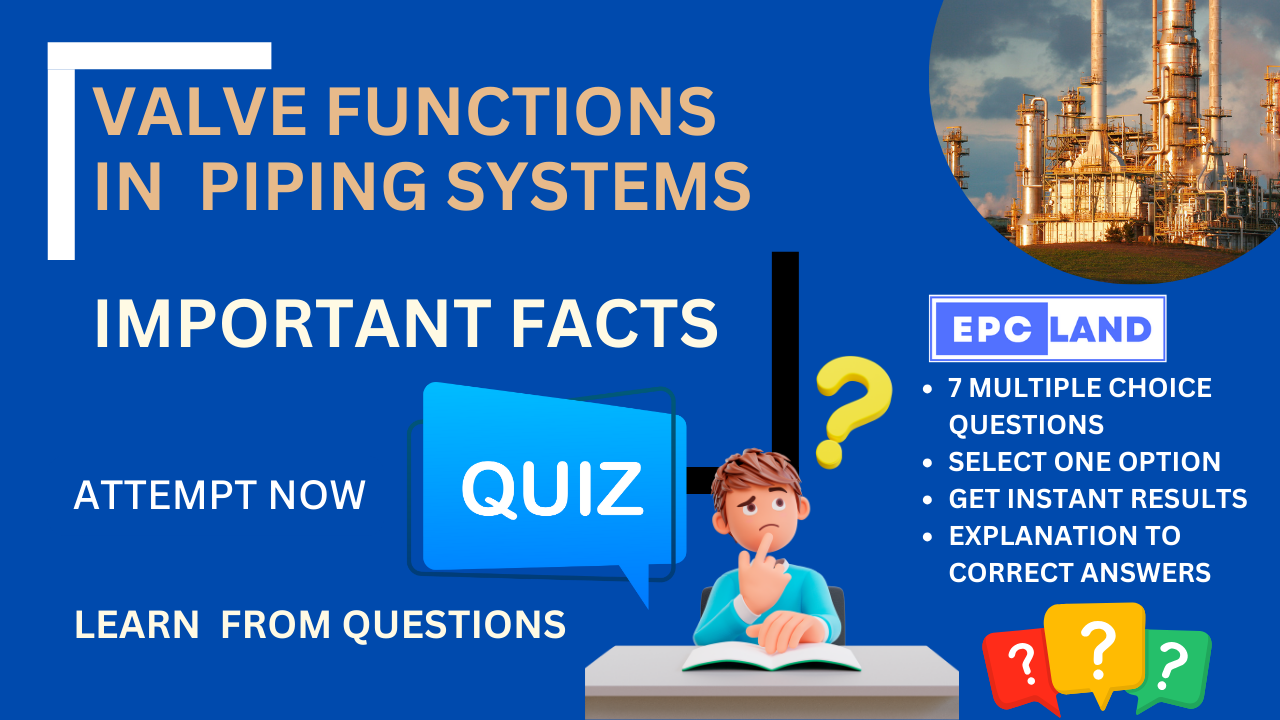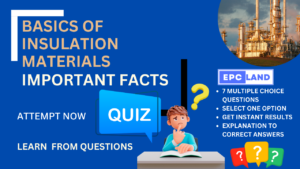1. Blocking Flow Valve Function
What is the primary purpose of blocking flow valves?
Explanation: Blocking flow valves are designed to completely stop the flow of fluid through a pipe, often for maintenance or emergency isolation.
2. Throttling Flow Valve Function
What is the primary function of throttling flow valves?
Explanation: Throttling flow valves are designed to control the flow of fluid through a pipe by varying the size of the opening in the valve.
3. Non-return Valve Function
What is the main purpose of non-return valves?
Explanation: Non-return valves are designed to prevent fluid from flowing in the opposite direction, protecting equipment and preventing backflow.
4. Blocking and Throttling Valve Function
How are blocking flow valves and throttling flow valves commonly used in a system?
Explanation: Blocking flow valves and throttling flow valves are often used together to control the flow of fluid in a system, each serving a specific purpose.
5. Use of Throttling Valves
When are throttling valves typically used?
Explanation: Throttling valves are typically used to control the flow of fluid to a specific rate or maintain a specific pressure in a system.
6. Non-return Valve Application
Where are non-return valves commonly applied?
Explanation: Non-return valves are commonly applied to prevent flow reversal and protect equipment, especially in situations where backflow could cause damage.
7. Valve Collaboration as Valve Function
How do non-return valves collaborate with other valves in a system?
Explanation: Non-return valves collaborate with both blocking flow valves and throttling flow valves to control the flow of fluid in a system.
Short Article on Valve Functions
1. Blocking Flow
Blocking flow valves are designed to completely stop the flow of fluid through a pipe. They are typically used in situations where it is necessary to isolate a section of a system for maintenance or to prevent the flow of fluid in an emergency. Blocking flow valves are often used in conjunction with other valves, such as throttling valves, to control the flow of fluid in a system.
2. Throttling Flow
Throttling valves are designed to control the flow of fluid through a pipe by varying the size of the opening in the valve. They are typically used in situations where it is necessary to regulate the flow of fluid to a specific rate or to maintain a specific pressure in a system. Throttling valves are often used in conjunction with other valves, such as blocking flow valves, to control the flow of fluid in a system.
3. Preventing Flow Reversal
Non-return valves, also known as check valves, are designed to prevent fluid from flowing in the opposite direction. They are typically used in situations where it is necessary to protect a pump or compressor from damage due to reverse flow, or to prevent backflow into the upstream part of a system due to process reasons. Non-return valves are often used in conjunction with other valves, such as blocking flow valves and throttling valves, to control the flow of fluid in a system.
Table of Contents
Don’t miss the Course on Effective Isometrics Management: Check Now
Enrollment Link
Recommended courses (Published on EPCLand)
- Complete Course on Piping Engineering
- Basics of Piping Engineering
- Piping Layout Engineering
- Piping Material Engineering
- Piping Stress Analysis
- Material Requisitions
- Piping Material Specifications
- Valve Material Specifications
- Plant Design & Layouts-OISD 118
- Isometric Management
Library of Technical Articles
Don’t miss out the collection of 15+ articles on following topics:
- Basics of Oil and Gas Industry
- Valves
- Testing
- Tank
- Piping Bulk Items
- Pipe
- Metallurgy
- Piping Materials
- Layout
- Instrumentation
- Heat Exchanger
- Type of Contracts
- Codes and Standards
- ASTM Standards
- Articles on Piping Specialty Items
Video details of Complete Course on Piping Engineering
Why Enroll in the EPCLand
Proven Track Record– PTR
Activities & Achievements before launching EPCLand
- Published more than 50+ short courses
- 3000+ Enrolments
- More than 3,500,00 Minutes of watch hours in the last 2 years
- 4000+ Students in 100+ Countries
- Rating of 4+ out of 5
- 1000+ YouTube Videos
- 8K+ Subscribers
What Students will Learn
- Codes & Standards of the Energy Sector
- Piping Material Engineering
- Piping Layout Engineering
- Stress Analysis
Interesting facts
- All the published courses have been developed by Industry Experts with more than 2 decades of experience
- Content is based on Practical experience and real-time problems.
- Content is designed and organized in such a manner that it can be easily grabbed.
- Complete website, Blogs and Quiz sections are Planned, Designed and published by myself (About me: Atul Singla)
- Complete flexibility of Time & Location, Students can access the content from anywhere & anytime
- Moreover, once enrolled, the content can be access as many times as you want, which helps in understand the fundamentals in a better way.
Conclusion
In conclusion, our courses are meticulously crafted by industry experts with over two decades of hands-on experience. The content is rooted in practical knowledge, addressing real-time problems. The material is thoughtfully designed and organized for easy comprehension. Every aspect, from the website to blogs and quizzes, has been planned, designed, and executed by Atul Singla, ensuring a comprehensive and seamless learning experience. With the flexibility of accessing the content at any time and from any location, students have the freedom to learn on their terms. Furthermore, enrollment grants unlimited access, allowing learners to revisit the material as often as needed, fostering a deep understanding of the fundamentals.



